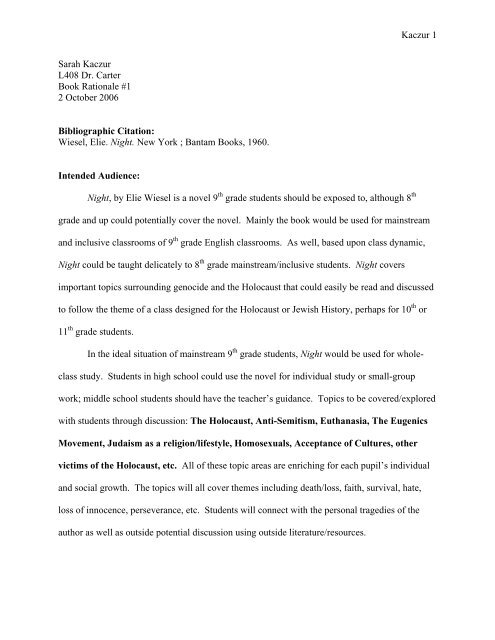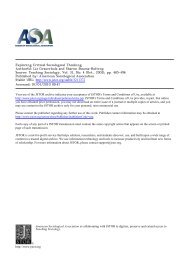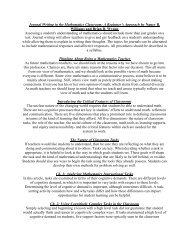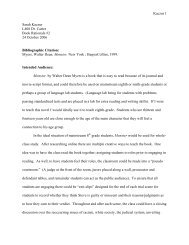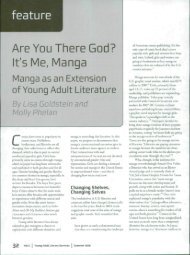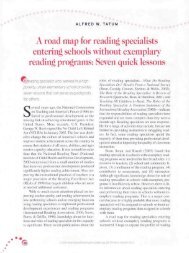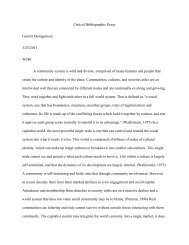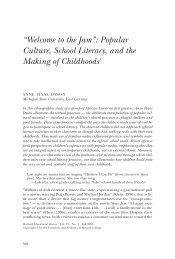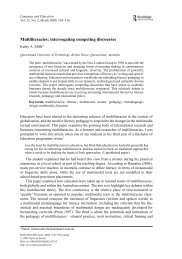Night. Night - Oncourse
Night. Night - Oncourse
Night. Night - Oncourse
You also want an ePaper? Increase the reach of your titles
YUMPU automatically turns print PDFs into web optimized ePapers that Google loves.
Kaczur 1<br />
Sarah Kaczur<br />
L408 Dr. Carter<br />
Book Rationale #1<br />
2 October 2006<br />
Bibliographic Citation:<br />
Wiesel, Elie. <strong>Night</strong>. New York ; Bantam Books, 1960.<br />
Intended Audience:<br />
<strong>Night</strong>, by Elie Wiesel is a novel 9 th grade students should be exposed to, although 8 th<br />
grade and up could potentially cover the novel. Mainly the book would be used for mainstream<br />
and inclusive classrooms of 9 th grade English classrooms. As well, based upon class dynamic,<br />
<strong>Night</strong> could be taught delicately to 8 th grade mainstream/inclusive students. <strong>Night</strong> covers<br />
important topics surrounding genocide and the Holocaust that could easily be read and discussed<br />
to follow the theme of a class designed for the Holocaust or Jewish History, perhaps for 10 th or<br />
11 th grade students.<br />
In the ideal situation of mainstream 9 th grade students, <strong>Night</strong> would be used for wholeclass<br />
study. Students in high school could use the novel for individual study or small-group<br />
work; middle school students should have the teacher’s guidance. Topics to be covered/explored<br />
with students through discussion: The Holocaust, Anti-Semitism, Euthanasia, The Eugenics<br />
Movement, Judaism as a religion/lifestyle, Homosexuals, Acceptance of Cultures, other<br />
victims of the Holocaust, etc. All of these topic areas are enriching for each pupil’s individual<br />
and social growth. The topics will all cover themes including death/loss, faith, survival, hate,<br />
loss of innocence, perseverance, etc. Students will connect with the personal tragedies of the<br />
author as well as outside potential discussion using outside literature/resources.
Kaczur 2<br />
Brief Summary:<br />
A young Jewish boy from Sighet, Transylvania gives you his personal experience of<br />
being cast to and surviving a Nazi concentration camp. Elie, the narrator tells of the horrific<br />
sights he experiences; from the furnaces, torture, selections, hangings, etc. Early on, Elie and his<br />
father are separated from his mother and sisters. Although his family was broken, Elie holds on<br />
to his father and continues with a strong will to survive the experience of living in a<br />
concentration camp. The young teen travels from Auschwitz to Buchenwald and endures the<br />
emotional and physical abuse that the Nazi soldiers readily disperse among the Jewish prisoners.<br />
Relationship of Book to Program:<br />
Ideally, students would be working with the teacher for a few months before introducing<br />
a book with the serious content level of <strong>Night</strong>. Since there is serious subject material to be<br />
discussed it is best that the class be respectful of one another and comfortable enough to engage<br />
in serious discussions. Perhaps right after winter break; students would have time to get to know<br />
one another and return to familiar faces with a fresh start into the second part of the year. <strong>Night</strong><br />
will be introduced with a little background on the history of the Holocaust, lead into a student<br />
journal response for students to begin critically thinking and connecting, and then lead into a full<br />
class discussion on the day students begin reading the novel. The book would be read in and<br />
outside of class by students but students will also have to choose an additional novel relating to<br />
one of the discussion topics for a personal book. Concluding the novel students will take a<br />
comprehensive test for overall assessment but students will also have to write an essay<br />
concluding the unit linking their outside chosen novel to an approved aspect of the novel <strong>Night</strong>.
Kaczur 3<br />
Ideally students will have an overall greater respect/understanding for the impact of the<br />
Holocaust and a greater sense of acceptance. Students, who could personally relate to the<br />
Holocaust or other issues discussed along with the novel, can share insights with the rest of the<br />
class that could help unknowing students gain an insight to the Holocaust.<br />
Teaching Objectives:<br />
The novel is a well-written, descriptive recollection that allows an introverted look to the<br />
truths of how Nazi concentration camps were run. Although the material is descriptive and<br />
sometimes hard to handle, it is a truthful recollection of history that students should study and<br />
understand.<br />
Insight to the Holocaust: Students will gain an overall understanding of the history of the<br />
Holocaust and how it impacted many Jewish lives today through the reading of the novel and<br />
classroom activities. As well, students will research their individual topic areas further while<br />
researching for their individual unit paper. Some assessment on the overall knowledge of the<br />
history will be shown through class discussion/engagement, small quizzes/exit slips, or included<br />
on the comprehensive test covering the novel <strong>Night</strong>.<br />
Critical Reading: Students will gain critical reading experience by engaging in small and large<br />
group reading. Worksheets, journaling, discussion topics and hands-on coinciding activities with<br />
the novel will help students gain a fuller comprehension for the novel and strengthen individual<br />
reading skills.<br />
Composition Experience/Practice: Students will compose descriptive and expository writing to<br />
show their understanding of the novel and multiple forms of composition. Journaling will allow<br />
students to explore their thoughts and understanding of the novel and should not be graded but
Kaczur 4<br />
rather used for completion/participation based grades. However, when students engage in<br />
researching, organizing, and compiling information to form comprehensive expository writing,<br />
they should be graded upon a pre-determined rubric. I would advise students have a rough draft<br />
due a week or two before the final copy with one or two classes between designed for class<br />
editing and teacher conferencing. Student will work individually and collaboratively to gain<br />
insights on class topic choices, editing skills, and socialization skills.<br />
Suggested Student Activities and Assignments:<br />
Journal Entries: Journal entries will be completed at the beginning of class after an initial<br />
discussion topic. Depending upon the day of the unit, the journal entries should be used to<br />
engage students and have them begin to critically think about the upcoming topic or discussion.<br />
As well, by having student complete a journal they have material in front of them to share<br />
throughout class activities/discussion and it is a completion based assignment that can earn<br />
students participation credit. Potential topics: What does the Holocaust mean to you Explain.<br />
Do you know anyone who has experienced such loss and suffering as Elie Who Why should<br />
literature like <strong>Night</strong> be taught to American society If you disagree, why<br />
Quizzes/Exit Slips: Short quizzes or exit slip questions can serve as a quick assessment tool to<br />
who is completing the expected reading and who is not; or those who do not comprehend the<br />
literature. Quizzes should be short; three to five questions involving short answer and fill in the<br />
blank over the expected reading for that class. As well, exit slips at the end of class serve as a<br />
good reflective tool for students and can help aide in assessment of class engagement with the<br />
material, understanding of discussion topics, and further insight to class questions covering
Kaczur 5<br />
subject material. Exit slips can be used for students to pose questions/concerns about class<br />
material/discussion for further planning.<br />
Rough Draft: The rough draft will be used for the teacher’s way of assessing student<br />
improvement as well as making sure students have chosen appropriate topic choices. Topic<br />
choices should be left up to the students but should be submitted and approved by the teacher<br />
prior to handing in rough drafts. Drafts should be assessed upon completion and following a few<br />
guidelines; the paper must relate their individual novel to <strong>Night</strong> by Elie Wiesel using citations<br />
where necessary to strengthen their argument/position, be 4-6 pages in length, MLA format, and<br />
include complete bibliographic citations for any outside materials used. The rough draft should<br />
be worth 30 points, the two editing workshops will both count as 10 points each and the final<br />
paper will be worth 50 points.<br />
Final Paper: The final paper will show what level of insight students gained and understand<br />
about the Holocaust and surrounding topics. The final paper will have the requirements of the<br />
rough draft as well as more detailed rubric based on the 6+1 trait grading system; conventions,<br />
ideas & content, organization, sentence fluency, voice, and word choice.<br />
Potential Problems with the Work:<br />
<strong>Night</strong> contains mature language and a description of happenings during the Holocaust and the<br />
effects the Holocaust continues to have on Jewish society. There are issues of death and loss that<br />
the main character experiences as a young teen that may be troublesome for some students to<br />
emotionally handle. However the graphic details of the Holocaust portray a truthful, first-hand<br />
experience of the tragic concentration camps. Students should be exposed to and taught to deal
Kaczur 6<br />
with the emotional feelings and insights behind studying the Holocaust to prevent a society that<br />
raises intellects without the knowledge of mistakes.<br />
Collection of Information About <strong>Night</strong>:<br />
The following journals are all pro-teaching <strong>Night</strong>, by Elie Wiesel; their citations conclude<br />
each article. The first article is from August 3, 2006 and disputing about how Utah schools are<br />
not allowed to discuss the Holocaust and how teachers in the community feel that the Holocaust<br />
should be studied. The article discusses how education in Utah is pressing to teach the<br />
Holocaust for multiple benefits stated in the article. The second article is from April 25, 2006<br />
and discusses how a teacher used <strong>Night</strong> in addition with other novels covering the Holocaust to<br />
teach and see improvement in the at-risk students. The Tulsa article discusses how the students<br />
could relate to the “survivors of intense violence” from the Holocaust, connected to the literature,<br />
and improved academically in the process. The last article discusses teaching tolerance and how<br />
important it is for teachers to diffuse myths of the Holocaust in a pursuit to teach the truths<br />
behind the Holocaust. It goes into how a teacher wrote to Elie and collected Holocaust materials<br />
from traveling around and collecting videos and books to enhance the teaching of the Holocaust.<br />
As well, the article spoke about a “resource pool” for teacher that was being compiled of<br />
scholars and Holocaust survivors who engage in school presentations/speeches.
Kaczur 7<br />
Copyright 2006 The Salt Lake Tribune<br />
All Rights Reserved<br />
The Salt Lake Tribune<br />
August 3, 2006 Thursday<br />
SECTION: LOCAL; Education<br />
LENGTH: 1102 words<br />
HEADLINE: State weighs curriculum for teaching about the Holocaust<br />
BYLINE: By Celia R. Baker The Salt Lake Tribune<br />
BODY:<br />
Utah public schools are not required to tell students about the annihilation of European Jews during<br />
World War II, or even mention the Holocaust.<br />
Nonetheless, a State Office of Education survey shows all Utah school districts teach about the<br />
Holocaust in some manner. But the amount of time spent, means of instruction and age at which<br />
students are introduced to Holocaust-related topics varies greatly across the state.<br />
Now, the State Board of Education is contemplating the establishment of requirements and guidelines<br />
for Holocaust instruction. Seventeen states have passed legislation regarding Holocaust instruction<br />
and many states have recommendations regarding curriculum. The board will discuss the matter<br />
Friday.<br />
Robert Austin, USOE's social studies specialist, said the informal survey he conducted in Utah mirrored<br />
findings from a national study: Instruction regarding the Holocaust is widespread in schools, but<br />
students spend more time exploring books such as The Diary of Anne Frank than learning about the<br />
Holocaust from history teachers.<br />
Kellie Richins, who teaches English to Lehi High School's junior classes, has her students spend about<br />
five weeks each year studying the book <strong>Night</strong>, by Holocaust survivor Elie Wiesel. To beef up<br />
historical background for the book, Richins teams with assistant principal Mari Braithwaite, who has a<br />
degree in history.<br />
Richins won a Holland-Knight Foundation fellowship and just returned from Washington, D.C., where<br />
she studied the Holocaust with Wiesel and other Holocaust survivors.<br />
Her experience in Washington, and her years in the classroom, have taught her that helping students<br />
learn about the Holocaust does more than inform them about past events.<br />
"The reason I feel so passionate about teaching it is because you can see the seeds of what started<br />
the Holocaust all around us," she said. "You see kids intolerant because other kids don't dress the<br />
same, don't have as much money or they are not the same religion. [Studying the Holocaust] helps<br />
kids to identify their prejudices, and their tendencies to label others and make bad judgments. Then<br />
we can prevent something like the Holocaust from ever happening again."<br />
There are pitfalls to be avoided in teaching about the Holocaust, she said. In past years, some of her<br />
students have felt frustrated by their perception that Holocaust victims did too little to defend<br />
themselves.<br />
"I caution them not to be critical," she said. "They can't completely understand the situation these<br />
people were in."<br />
Richins avoids making stereotypical generalizations regarding actions and motivations of either
Kaczur 8<br />
Germans or Jews, and uses discretion when showing period photographs and films.<br />
"I don't really think it's always necessary to show the most graphic pictures for students to understand<br />
the horror that took place," she said.<br />
Austin is not surprised language arts teachers devote more time to Holocaust studies than history<br />
teachers do.<br />
"History teachers in Utah are hard-pressed to cover so much historical material that it is difficult to go<br />
into depth on topics like this," he said. "Language arts teachers can work on literacy skills, story skills<br />
and research skills that are part of the language arts curriculum, and still focus more depth on this<br />
topic."<br />
The Holocaust Memorial Museum recommends that students be in at least seventh grade before they<br />
learn specific information about the more grisly aspects of state-sponsored genocide, Austin said.<br />
Some Utah schools approach the topic in upper elementary grades, often through fictional books such<br />
as Lois Lowry's novel Number the Stars.<br />
State school board member Teresa Theurer said a letter that questioned why Utah had no specific<br />
requirements sparked the board's interest in Holocaust curriculum. She doesn't know whether the<br />
board will determine that more direction is needed, or what that direction might be, but those<br />
questions might be answered Friday, she said.<br />
Austin said it won't matter. With or without involvement of the state school board or Legislature,<br />
educators "will continue to find more opportunities to provide Holocaust education," he said.<br />
cbaker@sltrib.com<br />
The U.S. Holocaust Memorial Museum defines "Holocaust" as "the state sponsored, systematic<br />
persecution and annihilation of European Jewry by Nazi Germany and its collaborators between 1933<br />
and 1945."<br />
It says the Holocaust should be studied because it:<br />
* Helps students understand the ramifications of prejudice, racism and stereotyping, and teaches<br />
them to value diversity.<br />
* Provides a context for exploring the dangers of remaining silent, apathetic and indifferent to<br />
oppression of others.<br />
* Helps students think about the use and abuse of power, and the responsibilities of individuals and<br />
nations when confronted with civil rights violations.<br />
* Gives students insight about how a convergence of events can cause disintegration of democratic<br />
values.<br />
Guidelines:<br />
* Avoid simple answers to complex history. Do not attempt to reduce Holocaust history to one or two<br />
catalysts.<br />
* Strive for precision of language. For instance, avoid categorizing all Germans as "collaborators" or all<br />
concentration camps as "killing centers."<br />
* Clarify the difference between primary and fictional sources.<br />
* Avoid stereotypical descriptions of groups and nationalities.<br />
* Be sensitive to appropriateness of written and audiovisual content.
Kaczur 9<br />
* Do not romanticize history. Overemphasis on heroic tales can cause inaccurate understanding;<br />
exposing students to the worst aspects of human nature fosters cynicism.<br />
* Some students can become intrigued with symbols of Nazi power. Help students understand how<br />
such elements can be abused and manipulated by governments to legitimize acts of terror.<br />
* Avoid gimmicky exercises, such as simulation activities that oversimplify and trivialize. Instead, use<br />
reflective writing assignments and in-class discussions to explore human behaviors such as fear,<br />
scapegoating, conflict resolution and decision-making.<br />
Links to USHMM and other social studies resources are available on the Utah State Office of<br />
Education's Web site at http://www.schools.utah.gov/curr/soc.st/general/links.html<br />
Holocaust national essay contest<br />
Holland-Knight, the foundation that presented the fellowship attended by Lehi High School teacher<br />
Kellie Richins, also sponsors a national essay contest that awards scholarships and weeklong trips to<br />
Washington, D.C., to high school students each year.<br />
The 2007 essay contest will begin in October of this year with an entry deadline in late April or early<br />
May of 2007.<br />
Complete details on the Holocaust Remembrance Project can be found at http://holocaust.hklaw.com.<br />
LOAD-DATE: August 3, 2006<br />
Terms and Conditions | Privacy<br />
Copyright © 2006 LexisNexis, a division of Reed Elsevier Inc. All Rights Reserved.<br />
http://bert.lib.indiana.edu:2093/universe/document_m=c45b8a219a05f76e382f0f801db61721&_docnum=10<br />
&wchp=dGLbVlz-zSkVb&_md5=e66be62724391ef915249ff92706070d<br />
SECTION: News; Tulsa; Education; Pg. A10<br />
LENGTH: 802 words<br />
Copyright 2006 The Tulsa World<br />
Tulsa World (Oklahoma)<br />
April 25, 2006 Tuesday<br />
Final Home Edition<br />
HEADLINE: Teacher uses Holocaust to help 'at-risk' students<br />
BYLINE: GINNIE GRAHAM World Staff Writer<br />
BODY:<br />
Students in a high school class took bets on how long their new, 23-year-old teacher would stay.
Kaczur 10<br />
They made it clear they did not care what she had to say. They were labeled "at-risk" and<br />
"unteachable" by school administrators. It was 1994 in Long Beach, Calif. Racial tensions were at a<br />
boiling point, and students aligned themselves with ethnic gangs ruling their streets.<br />
"I was overwhelmed and experienced what so many brand-new teachers go through -- the disconnect<br />
between theory and practice," Erin Gruwell said.<br />
One day Gruwell swiped a note being passed in class and reacted angrily to the caricature of a black<br />
student. She compared it to the Nazi propaganda used against Jews during the Holocaust.<br />
The students did not know what she was talking about.<br />
"Here, the culture was one of prolific gangs," Gruwell said. "When you're caught up in that lifestyle,<br />
going to school, reading, writing and learning your history lessons are not on the radar."<br />
Gruwell decided to put it on their radar. She gave them books such as "Anne Frank: The Diary of a<br />
Young Girl," "<strong>Night</strong>" by Elie Wiesel and "Zlata's Diary: A Child's Life in Sarajevo."<br />
Something clicked.<br />
Students related to these survivors of intense violence. Most had scars from guns, knives and<br />
beatings. They found parallels in their lives and of the authors'.<br />
Each began keeping a journal of the struggles with physical and mental abuse, drugs and violence.<br />
They stayed after school, showed up on weekends for field trips and raised money to bring the woman<br />
who sheltered Anne Frank to their classroom.<br />
The students named themselves "The Freedom Writers" after the 1960s civil rights activists, The<br />
Freedom Riders.<br />
"At that serendipitous moment, everything became relevant," Gruwell said. "It became about how to<br />
take that moment of intolerance and make them tolerant by using examples of their own lives.<br />
"It was not uncommon for a student to have lost one to two dozen friends and family to gang<br />
violence. One student felt like he had been living in an undeclared war zone."<br />
The teacher chronicled her experience in "The Freedom Writers Diary -- How a Teacher and 150 Teens<br />
Used Writing to Change Themselves and the World Around Them," which is being made into a movie<br />
starring Hilary Swank, Patrick Dempsey and Imelda Staunton set for release in January.<br />
Gruwell will be the keynote speaker at the Business and Education Forum hosted by the Tulsa chapter<br />
of Executive Women International. The forum will be at 5:30 p.m. Thursday at the Reynolds Center at<br />
the University of Tulsa, 11th Street and Harvard Avenue.<br />
"There are kids who feel different or on the outside everywhere," Gruwell said. "This is about giving<br />
them a voice, letting them be heard and having someone to listen. The stories are universal."<br />
Her teaching style went outside any packaged curriculum and testing standards. She found books the<br />
students wanted to read and would find relevant. She let them lead the way.<br />
"The standards of education have politicized education," Gruwell said. "I feel strongly that education is<br />
the best way to equalize the playing field. Through education, we can right wrongs.<br />
"For me, it's more important to teach to the student and not teach to a test. By teaching students in<br />
a way that engages and empowers them, they can take any test and fly. There was accountability<br />
built into the teaching."<br />
The 150 students in that class graduated from high school, and many pursued college degrees. Some<br />
have entered into professions of law, medicine, education and social work.
Kaczur 11<br />
The class continues to regroup for projects such as a fundraiser in 1997 for the Holocaust Museum in<br />
Washington, D.C., and a European trip in 1999 to visit concentration camps and Anne Frank's house in<br />
Amsterdam.<br />
Gruwell founded the Erin Gruwell Education Project, which provides scholarships for disadvantaged<br />
students and promotes innovative teaching methods. Proceeds from the book sales go to the<br />
scholarship fund.<br />
The Freedom Writers students often speak to community groups for the foundation, and some work<br />
for it.<br />
Executive Women International's forum is a fundraiser for two Tulsa scholarship programs -- Adult<br />
Students in Scholastic Transition and one benefiting high school students. Last year, the group gave<br />
nearly $25,000 in scholarships in the programs.<br />
Ginnie Graham 581-8376<br />
ginnie.graham@tulsaworld.com<br />
Forum at TU What: Business and education forum featuring Erin Gruwell, author of "The Freedom<br />
Writers Diary"<br />
When: 5:30 p.m. Thursday<br />
Where : Reynolds Center at the University of Tulsa, 11th Street and Harvard Avenue<br />
Cost : Tickets are $10 each. For tickets, contact Marnie Knight at 249-4033 or e-mail at<br />
marnie@admiralexpress.com, or contact Jody Davis-Bergman at 251-5594 or e-mail at<br />
jodybergman@accentmoving.com.<br />
For more: Go to www.ewitulsa.org .<br />
LOAD-DATE: April 26, 2006<br />
Terms and Conditions | Privacy<br />
Copyright © 2006 LexisNexis, a division of Reed Elsevier Inc. All Rights Reserved.<br />
http://bert.lib.indiana.edu:2093/universe/document_m=c45b8a219a05f76e382f0f801db61721&_docnum=11<br />
&wchp=dGLbVlz-zSkVb&_md5=70e6a404eace58c47bf70fcf280de7c6<br />
Copyright 2006 The Deseret News Publishing Co.<br />
Deseret Morning News (Salt Lake City)<br />
LENGTH: 676 words<br />
HEADLINE: Holocaust hits home for class<br />
BYLINE: Laura Hancock Deseret Morning News<br />
August 28, 2006 Monday
Kaczur 12<br />
BODY:<br />
LEHI -- Kellie Richins saves letters from Elie Wiesel in the same box in which she keeps cards from<br />
her husband. The letters from the Nobel Peace Prize recipient and author, she says, are as precious to<br />
her as notes from her spouse.<br />
Last fall, after her junior-class students at Lehi High School finished Wiesel's book, "<strong>Night</strong>," the<br />
English teacher was inspired to learn more about the Holocaust and why 11 million people -- including<br />
Jews, mentally ill, physically handicapped, those considered gypsies, Jehovah's Witnesses and<br />
homosexuals -- were put to death.<br />
"I wanted more knowledge for myself," she said, "so I could share it with my students."<br />
Richins wrote a letter to Wiesel and invited students to do the same. He responded with two letters:<br />
one for the students, one for Richins. She now has both letters at home.<br />
The Alpine educator also applied -- and was accepted -- to the Holocaust Remembrance Project.<br />
Richins, who had to write an essay as part of her application, attended with six other teachers and a<br />
handful of students from across the United States.<br />
Richins was able to meet Wiesel during the July 16-22 project. She said she felt intimidated while<br />
penning her letter to him. After all, she said, his writing in "<strong>Night</strong>," which describes his experiences as<br />
a teen in the Auschwitz and Buchenwald concentration camps during World War II, was so strong and<br />
clear.<br />
"And then I promised him, I made a pledge for me personally, that I would never forget what the Jews<br />
had to suffer because of their religious convictions," she said. "I would do my part not to permit<br />
intolerance and not blame my problems on another race."<br />
Wiesel responded graciously. "Your students are privileged to learn from a person with such<br />
commitment to education and memory," he wrote. "I am honored to share the teaching profession<br />
with someone like yourself."<br />
Wiesel's letter to the six Lehi students contained comments for each of them.<br />
One student asked Wiesel how the experience changed his Jewish faith.<br />
"Even during those dark times, I never lost my faith in God," Wiesel wrote. "Rather, I protested<br />
against and questioned God's silence. I still believe in God but my faith is a wounded faith."<br />
Richins went to Washington, D.C., to tour the U.S. Holocaust Memorial Museum and visit with nine<br />
Holocaust survivors.<br />
"(The survivors) traveled with us everywhere we went," she said. "They ate every meal with us. They<br />
each shared their own story with us. They were a wealth of information. They were right there. We<br />
could ask them anything we wanted, any time of day."<br />
She returned to Utah with $1,500 in educational materials such as videos and books she believes will<br />
enhance teaching of Holocaust-era literature. Richins will donate some of the materials to the Alpine<br />
School District, she says, to assist other teachers.<br />
The value of teachers traveling to receive Holocaust education is that they will obtain correct materials<br />
to diffuse myths, said Pat Drussel, a teacher at Provo's Dixon Middle School who is working with the<br />
Utah State Office of Education on Holocaust education.<br />
They also learn about the importance of teaching tolerance, she said.
Kaczur 13<br />
Last year, Drussel was a U.S. Holocaust Museum teacher fellow. Before that, she toured concentration<br />
camps and ghettos in Europe.<br />
"My big push to my students is for them to have tolerance and to accept diversity," Drussel said. "And<br />
to accept all of the differences only makes us a better group of people."<br />
Utah's core curriculum, which specifies what teachers should convey to students for each subject and<br />
grade level, does not require teachers to teach lessons about the Holocaust.<br />
However, a survey by the State Office of Education showed that students are learning about it in social<br />
studies and literature classes.<br />
Drussel said that she offers classes for teachers on how to present the Holocaust. Last month, for<br />
instance, she visited teachers in Cedar City.<br />
Drussel also is compiling for teachers a "resource pool" of scholars and local Holocaust survivors who<br />
are willing to visit schools. E-mail: lhancock@desnews.com<br />
LOAD-DATE: August 28, 2006<br />
Terms and Conditions | Privacy<br />
Copyright © 2006 LexisNexis, a division of Reed Elsevier Inc. All Rights Reserved.<br />
http://bert.lib.indiana.edu:2093/universe/document_m=c45b8a219a05f76e382f0f801db61721&_docnum=2&<br />
wchp=dGLbVlz-zSkVb&_md5=f1988e838d97c24c6e59d1164a403255<br />
Collection of Supplementary Information:<br />
A Biographical Overview<br />
Elie Wiesel, winner of the Nobel Peace Prize in 1986, was born in the provincial town<br />
of Sighet, Romania on September 30, 1928. A Jewish community had existed there<br />
since 1640, when it sought refuge from an outbreak of pogroms and persecution in<br />
Ukraine.<br />
His maternal grandfather, Reb Dodye Feig, was a devout Hasidic Jew, whose influence<br />
on Wiesel was deep, and inspired him to pursue Talmudic studies in the town's<br />
Yeshiva. However his father Shlomo, who ran a grocery store, although also religious,<br />
was regarded as an emancipated Jew, open to events of the world. He insisted that<br />
his son study modern Hebrew as well, so that he could read the works of<br />
contemporary writers. And at home in Sighet, which was close to the Hungarian<br />
border, Wiesel's family spoke mostly Yiddish, but also German, Hungarian and<br />
Romanian. Today, Wiesel thinks in Yiddish, writes in French, and, with his wife Marion<br />
and his son Elisha, lives his life in English.<br />
Wiesel at age 15
Kaczur 14<br />
Grandfather<br />
Reb Dodye Feig<br />
Life for Wiesel and his extended family changed tragically in 1943 and 1944, when Nazi<br />
Germany decided that the Jews living in the Axis nations of Eastern Europe — Romania,<br />
Hungary, and Bulgaria — should share the fate of the rest of European Jewry and be<br />
transported to the death camps of Poland. Grandfather Dodye went first, when he and his<br />
three sons and their children where taken away in 1943. The following year, Wiesel's entire<br />
family, his mother, father and his three sisters, were transported with him to Poland. Only<br />
Wiesel and his two older sisters survived.<br />
Liberated from Auschwitz - Buchenwald by the American Third Army in 1945, he was sent to<br />
France to study as part of a group of Jewish children orphaned by the Holocaust. There he<br />
was given a choice — secular studies, or religious studies. Wiesel's faith had been severely<br />
wounded by his experiences in Auschwitz and three other concentration camps. He felt God had turned his<br />
back on the Jews. But, despite his bitterness, he chose to return to religious studies:<br />
"My only experience in the secular world," he explains, "was Auschwitz."<br />
Sent to Paris to study at the Sorbonne after several years of preparatory schools,<br />
he became a journalist for a small French newspaper, and supplemented his<br />
meager income as a translator and Hebrew teacher. Persuaded by the<br />
distinguished French Catholic writer Francois Mauriac, he finally put down on<br />
paper the experiences he had vowed to recount only after ten years of silence.<br />
The result was "<strong>Night</strong>", an internationally acclaimed memoir that has been<br />
translated into 30 languages and has sold more than seven million copies, the<br />
income from which goes to support a yeshiva in Israel established by Wiesel in<br />
memory of his father.<br />
Wiesel's entry card to Paris<br />
Wiesel has, since then, dedicated his life to ensuring that the murder of six million Jews would never be<br />
forgotten, and that other human beings would never be subjected to genocidal homicide.<br />
Most of the 40 books he has written since — novels, collections of essay, plays — explore the subject that<br />
haunts him, the events that he describes as "history's worst crime." Speaking, writing, traveling incessantly,<br />
he has become a spokesman for human rights wherever they are threatened — in the former Soviet Union,<br />
Rwanda, Bosnia, Kosovo — and with the Nobel Peace Prize award established the Elie Wiesel Foundation for<br />
Humanity.<br />
Assigned to New York in 1956 as a correspondent for an Israeli newspaper, Wiesel was struck by a taxi while<br />
crossing the street and was hospitalized for months. Still a stateless person at the time, unable to travel to<br />
France to renew his identity card and unable to receive a US visa without it, he found that he was eligible to<br />
become a legal resident. Five years later, he received an American passport, the first passport he had ever<br />
had. Years later, when his then close friend Francois Mitterand became President of France, he was offered<br />
French nationality.<br />
"Though I thanked him," he writes in his memoirs, "and not without some emotion, I declined the offer.<br />
When I had needed a passport, it was America that had given me one."<br />
In 1978 President Carter named Wiesel to chair the President's Commission on the<br />
Holocaust, which recommended the creation of a national day of remembrance and the<br />
US Holocaust Memorial Museum, both subsequently created by acts of Congress.<br />
He has been Distinguished Professor of Judaic Studies at the City University of New York<br />
(1972-76), Henry Luce Visiting Scholar in Humanities and Social Thought at Yale<br />
University (1982-83), and since 1976 has occupied the Mellon Chair in the Humanities at<br />
Boston University.<br />
Wiesel on a boat<br />
to Israel in 1949<br />
Along with the Nobel Peace Prize, he has been awarded the Presidential Medal of<br />
Freedom, the United States Congressional Gold Medal, and the Grand Croix of the French<br />
Legion of Honor.<br />
http://www.pbs.org/eliewiesel/life/index.html
Kaczur 15<br />
<strong>Night</strong><br />
Elie Wiesel<br />
Setting: Concentration camps throughout Germany, during World War II. Auschwitz,<br />
Birkenau, and Buna.<br />
Background Information:<br />
During World War II, Hitler formed many concentration camps throughout Germany and<br />
Poland. In these camps the people imprisoned, mainly of Jewish or Gypsy descent, were tortured,<br />
starved, put through horrific conditions, killed, and worked to death.<br />
Major Characters:<br />
Elie Wiesel- He tells his heart wrenching story of his imprisonment in Nazi Germany. He<br />
overcame the odds with his strength and will to live.<br />
Elie's Father- He gave Elie the strength to go on without him and to save himself. He died in the<br />
40 mile march between concentration camps in the dead of winter.<br />
Plot Summary:<br />
The autobiography began in 1941 with Elie and his family living in Sighet, an area in Germany.<br />
In 1944 German and Hungarian police set up ghettos where all the Jews and other religious and<br />
ethnic people were kept, and Elie and his family were basically kept captive in this area by the<br />
Gestapo. This was just until they were to be taken away to the concentration camps. When Elie<br />
and his family arrived at the concentration camp in Birkenau, he was separated from his mother<br />
and sister, whom he later found out had been killed. It was hard for him to deal with the fact that<br />
he would never see them again, and he wanted to give up. Elie almost killed himself while he<br />
was on the line waiting to get into the camp, facing the fire pits. A line straying to the left and<br />
one to the right decided his fate. If he was pointed on the right line, he would be immediately<br />
sent to the fire pit. He lied saying that he was 18, but was actually 14. When he was almost at the<br />
front of the line, he decided to throw himself at the barbed wire fence, rather than dying by fire.<br />
He changed his mind when the line suddenly shifted and he didn't have to go in the fire after all.<br />
He was relieved, but also dispirited by knowing that he would never see his mother and sister<br />
again.<br />
Elie's father kept him going, constantly saying that they would make it, and that he should never<br />
lose his faith. Upon arriving, all the men had to give in their clothes and personal articles, and get<br />
checked physically by the SS troops to see their physical condition, and to deplete them of any<br />
confidence and privacy they had left.<br />
They were sent off to Auschwitz where they were put to work. They couldn't say they were<br />
skilled workers, because as a result they would be separated. Elie worked in a factory, where he
Kaczur 16<br />
met a lot of people, including a girl from France. He was separated from his father at that time.<br />
He liked Auschwitz better because it was cleaner and set up nicer than Birkenau. He had become<br />
numb to beatings by now, and had witnessed numerous hangings of his friends at the camp.<br />
He was then sent from Auschwitz to Buna with his father. He had become accustomed to the<br />
stench of burning bodies. He injured his foot, which caused him to have an operation. After the<br />
operation, the camp was sent out to march because the Russians were coming to bomb the<br />
camps. Elie was told not to stay in the hospital because he would be killed. So, he went out with<br />
his weak father and barely healed foot to march. It was the middle of the winter, and none of the<br />
prisoners were dressed well enough. They were headed for Buchenwald, which was a forty-two<br />
mile march. They had to run for most of the time. Once they reached Buchenwald, they rested<br />
for awhile. Elie's father passed away at the camp from dysentery. Elie had to continue going on<br />
without his father. They were later liberated at Buchenwald, and Elie was one of the very few to<br />
survive.<br />
Themes:<br />
• Death<br />
• Faith<br />
• Hatred<br />
• Survival<br />
• Perseverance<br />
• Loss of Innocence<br />
Key Issues:<br />
Death-- A theme which was used throughout the book. It was shown through the loss of loved<br />
ones, especially when Elie lost his entire family to the concentration camps. It was also shown<br />
through the constant torture that went on, and the putrid smell of dead bodies penetrating in the<br />
prisoner's nostrils.<br />
Faith - Elie was told by his father to never lose his faith of his religion it would help him through<br />
everything, and keep him strong. At first Elie wasn't sure of his faith because if there was a God,<br />
then why did he create the situation that they were in.<br />
Hatred - The Nazi's acted through hatred against the Jews, Gypsies, and many others who stood<br />
in their way. They killed and tortured for no other reason than hate. The hate prevailed over all<br />
and it took over the minds of everyone.<br />
Loss of Innocence - Elie was a young boy when he was taken to the concentration camps, and<br />
he led a sheltered life. He did not realize how cruel people could be, and what far measures they<br />
would take when faced with power and death. He saw the torture, and the death of his family,<br />
which brought him great pain, but also made him grow up and face reality.<br />
Morals and Life Applications:
Kaczur 17<br />
The autobiography, <strong>Night</strong> , by Elie Wiesel is written proof of the real life horror that existed<br />
during the Holocaust. It is not fiction, therefore its life applications are evident. One should never<br />
lose faith or whatever guiding force that may keep them going. This faith was the only force that<br />
helped Elie to survive, and without this faith Elie would have surely succumbed to dying. Some<br />
morals of this autobiography are that life is not always fair, and people are not either. People<br />
give in to power to save themselves and protect their own lives. People will sometimes hurt<br />
others, even those close to them, if put in a life or death situation. The major purpose of this<br />
autobiography is to recount the events that took place during the Holocaust. One may think that<br />
Elie wrote his story to tell people of the great tragedy that took the lives of his family and of<br />
millions of others that were taken for no reason at all.<br />
http://www.bellmore-merrick.k12.ny.us/night.html<br />
Approximately 11 million people were killed because of Nazi genocidal policy. It was the<br />
explicit aim of Hitler's regime to create a European world both dominated and populated by the<br />
"Aryan" race. The Nazi machinery was dedicated to eradicating millions of people it deemed<br />
undesirable. Some people were undesirable by Nazi standards because of who they were, their<br />
genetic or cultural origins, or health conditions. These included Jews, Gypsies, Poles and other<br />
Slavs, and people with physical or mental disabilities. Others were Nazi victims because of what<br />
they did. These victims of the Nazi regime included Jehovah's Witnesses, homosexuals, the<br />
dissenting clergy, Communists, Socialists, a-socials, and other political enemies.<br />
Those believed by Hitler and the Nazis to be enemies of the state were banished to camps. Inside<br />
the concentration camps, prisoners were forced to wear various colored triangles, each color<br />
denoting a different group. The letters on the triangular badges below designate the prisoners'<br />
countries of origin.<br />
Jews<br />
This photo shows a chart of the prison badges used in concentration camps.
Kaczur 18<br />
Antisemitism was a familiar part of European political life in the 1800s. Political<br />
antisemitism was preceded by centuries of religious persecution of Europe's Jews. There is<br />
evidence as early as 1919 that Hitler had a strong hatred of Jews. As Chancellor and later<br />
ReichsfŸhrer, Hitler translated these intense feelings into a series of policies and statutes which<br />
progressively eroded the rights of German Jews from 1933-1939.<br />
At first, the Nazis boycotted Jewish businesses for one day in April 1933. Then legislation<br />
excluded Jews from certain professions. The Nuremberg Laws created very detailed Nazi<br />
definitions of who was Jewish. Many people who never considered themselves Jewish suddenly<br />
became targets of Nazi persecution.<br />
The world accessible to German Jews narrowed. Jews were no longer allowed to enter cinemas,<br />
theaters, swimming pools, and resorts. The publishing of Jewish newspapers was suspended.<br />
Jews were required to carry identification cards and to wear Star of David badges. On one night,<br />
Nazis burned synagogues and vandalized Jewish businesses. The arrests and murders that<br />
followed intensified the fear Jews felt. Next, Jewish children were barred from schools. Curfews<br />
restricted Jews' time of travel and Jews were banned from public places. Germany began to expel<br />
Jews from within its borders.<br />
Germany's invasion of Poland in late 1939 radicalized the Nazi regime's policy toward Jews.<br />
Hitler turned to wholesale death of the European Jewish population. He swept Jewish<br />
populations into ghettos in eastern Europe. Simultaneously, mobile squads killed millions. The<br />
next step was to send Jews to squalid concentration and death camps. Approximately six million<br />
died for one reason: they were Jewish.<br />
More information about Jewish victims of the Holocaust, with links to other Web sites<br />
and documentary materials.<br />
Roma (Gypsies)<br />
The Roma, a nomadic people believed to have come originally from northwest India, consisted<br />
of several tribes or nations. Most of the Roma who had settled in Germany belonged to the Sinti<br />
nation. The Sinti and Roma had been persecuted for centuries. The Nazi regime continued the<br />
persecution, viewing the Roma both as asocial and as racially inferior to Germans.<br />
Although the Nuremberg Laws did not specifically mention them, Roma were included in the<br />
implementation of the statutes. Like Jews, they were deprived of their civil rights. In June 1936,<br />
a Central Office to "Combat the Gypsy Nuisance" opened in Munich. By 1938, Sinti and Roma<br />
were being deported to concentration camps.<br />
The fate of the Romani peoples paralleled that of the Jews after the beginning of World War II:<br />
systematic deportation and murder. First, western European Roma were resettled in ghettos.<br />
Then they were sent to concentration and extermination camps. Many Roma in the east--Russia,
Kaczur 19<br />
Poland, and the Balkans--were shot by the Einsatzgruppen.<br />
Sinti and Roma were killed during the Holocaust.<br />
In total, hundreds of thousands of<br />
Further information about the Sinti and Roma, a photo, and links to other Web sites.<br />
Poles and Other Slavs<br />
It is often forgotten that Christian Poles and other Slavs, notably Ukrainians and Byelorussians,<br />
were also primary targets of Nazi Germany hatred during World War II. To the Nazis, the Slavs<br />
were considered Untermenschen,or subhumans, and nothing more than obstacles to gaining<br />
territory necessary for the superior German race. This philosophy is apparent in Hitler's<br />
statement, "The destruction of Poland is our primary task. The aim is not the arrival at a certain<br />
line but the annihilation of living forces...."<br />
The combination of a Nazi genocidal policy and the Nazis' thirst for more living space resulted<br />
in disaster for Polish, Ukrainian, and Byelorussian populations. Millions of Slavs were deported<br />
to Germany for forced labor. Intelligentsia, consisting of teachers, physicians, clergy, business<br />
owners, attorneys, engineers, landowners, and writers, were imprisoned in concentration camps<br />
or publicly executed. Tens of thousands of Ukrainians were executed by mobile killing squads,<br />
or Einsatzgruppen.<br />
Those who were sent to camps had to wear badges, of course. There was not one badge<br />
designation for Poles and other Slavs. Rather, a Polish or Slavic person was categorized as a<br />
criminal, asocial, political prisoner, and so on.<br />
Millions upon millions of non-Jews were slaughtered in the Slavic countries.<br />
Further information about the Nazi treatment of the Polish people.<br />
Political Dissidents and Dissenting Clergy<br />
The remnants of the Communist and Socialist parties and members of the trade unions resisted<br />
the Nazi regime. Especially in the early years of the Third Reich, political prisoners were a<br />
significant portion of the concentration camp inmates. At the end of July 1933, about 27,000<br />
political prisoners were being held in concentration camps in "protective custody." During its<br />
twelve year existence, Dachau was always a camp for political prisoners.<br />
In 1933, the Roman Catholic Church signed a concordat or agreement with the new Nazi<br />
government, recognizing the legitimacy of the Third Reich. The Protestant Church was united<br />
into a single Reich Church under one bishop. In September 1933, Martin Niemöller, a pastor of a<br />
fashionable church in Berlin, set up a Pastors' Emergency League which led to the formation of<br />
the anti-Nazi Confessional Church. This church wrote a memorandum to Hitler attacking the<br />
government's anti-Christian campaign, policies of antisemitism, and terrorizing tactics. Hitler
Kaczur 20<br />
responded with a crackdown on members of the Confessional Church. Hundreds of dissenting<br />
clergy were arrested, many were imprisoned, and also executed.<br />
Further information about the Nazi treatment of political prisoners and dissenting clergy.<br />
Persons with Physical or Mental Disabilities<br />
These people never were assigned a badge because they were rarely sent to concentration camps.<br />
Persons with physical or mental disabilities threatened the Nazi plan for human "perfection."<br />
In 1934, forced sterilization programs sterilized 300,000 - 400,000 people, mainly those in<br />
mental hospitals and other institutions. Propaganda was distributed which helped build public<br />
support for these government policies. Persons who were mentally ill or physically disabled were<br />
stigmatized, while the costs of care were emphasized in propaganda campaigns.<br />
In 1939, a Nazi "euthanasia program" began. This term is used as a euphemism for the Nazi<br />
plan to murder those with physical or mental defects. Unlike the sterilization program, the<br />
"euthanasia" program was conducted in secrecy. "Operation T4" was the code term used to<br />
designate this killing project.<br />
As word leaked out about the "euthanasia" program, some church leaders, parents of victims,<br />
physicians, and judges protested the killings. Hitler ordered the end of Operation T4 in August<br />
1941. However, the murders continued in a decentralized manner. Doctors were encouraged to<br />
kill patients with disabilities by starvation, poisoning, or injection.<br />
Further information about the Nazi treatment of persons with physical or mental<br />
disabilities.<br />
Jehovah's Witnesses<br />
In 1933, the Jehovah's Witnesses in Germany totaled about twenty thousand. Although their<br />
religious meetings were outlawed after the Nazi rise to power, many continued to practice their<br />
religion. In 1934, Jehovah's Witnesses attempted to fend off Nazi attacks by having<br />
congregations send letters to the government explaining their beliefs and political neutrality.<br />
The Nazis did not tolerate the Jehovah's Witnesses' refusal, which was based on religious<br />
principles, to salute flags, to raise their arms to "Heil Hitler,"or to serve in the German army. The<br />
group was banned by national law in April 1935. Those Witnesses who defied the ban on their<br />
activities were arrested and sent to prisons and concentration camps.<br />
Marked with purple triangular badges, the Witnesses were a relatively small group of prisoners<br />
in the concentration camps, numbering several hundred per camp. If Jehovah's Witnesses within<br />
the camps signed documents renouncing their religious beliefs, they would be freed. Very few,<br />
even in the face of torture, signed the declarations. In all, about 10,000 Jehovah's Witnesses were
Kaczur 21<br />
imprisoned in concentration camps. Of these, approximately 2,500 to 5,000 died in Dachau,<br />
Belsen, Buchenwald, Auschwitz, and other camps.<br />
Further information about the Nazi treatment of the Jehovah's Witnesses.<br />
Homosexuals<br />
A state policy of persecution of homosexuals began in Germany in 1933. Publications by and<br />
about homosexuals were prohibited and burned. In 1934, a special Gestapo division on<br />
homosexuals was set up. A criminal code relating to homosexuality was amended and made<br />
harsher. German police raided gay clubs and bars and made arrests.<br />
Some homosexuals spent time in regular prisons, and an estimated 5,000-15,000 were sent to<br />
concentration camps. Even within the confines of the camps, homosexuals were mistreated and<br />
tormented by other inmates.<br />
The Nazi regime claimed its concern about homosexuality related to keeping the Aryan birthrate<br />
high. German and Austrian gays were subject to arrest and imprisonment, but in Germanoccupied<br />
countries, Nazis did not deport homosexuals and send them to camps.<br />
Memorial photographs, Web links, and a bibliography related to homosexual victims of<br />
the Third Reich.<br />
Other Victims<br />
When the Nazis came to power there were hundreds of African-German children living in the<br />
Rhineland. They were the offspring of German mothers and African soldiers brought in during<br />
the French occupation. In Mein Kampf ,Hitler claimed these children were part of a Jewish<br />
plot to begin "bastardizing the European continent at its core." Under the Nazi regime, African-<br />
German children were labeled "Rhineland Bastards" and forcibly sterilized.<br />
Asocials were another category of people that Nazis deemed undesirable, and necessary for<br />
eradication. Nazis targeted numerous vagrants, prostitutes, alcoholics, and others who were<br />
considered unfit for society.<br />
Interactive quiz on victims.<br />
Lesson plans, discussion questions, term paper topics, reproducible handouts, and other<br />
resources for teaching about victims are available here.<br />
HTTP://FCIT.COEDU.USF.EDU/HOLOCAUST/PEOPLE/VICTIMS.HTM
Kaczur 22


